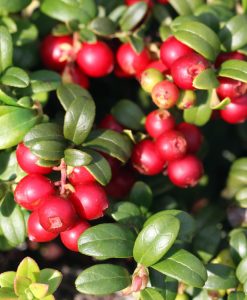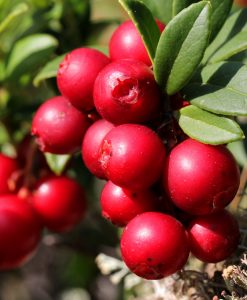[vc_row][vc_column][vc_column_text]
[/vc_column][/vc_row]
The Lingonberry is a close relative of the Cranberry and Blueberry. Plants yield hundreds of small bright red berries. Research demonstrates the fruits have health benefits. Some health devotees even claim Lingonberries have anti-inflammatory, urinary health and heart health properties. The fruit has many culinary uses; the most popular is to create a jelly made from a blend of Lingonberries, sugar and vanilla, an indispensable condiment on the Scandinavian dinner table. The plants grow wild on the floor of the Nordic woods, and every fall, entire families fan out in the fir-covered forests to scoop them up and take them home. The harvested berries can simply be thrown in a freezer and used as needed by mixing at slow speed. Cooking is not needed, unless making a preserve. The plants range from 6 to 12 inches tall and are stoloniferous, spreading outward several feet within six years if not trained. The plants grow slowly and are not invasive, as they are native to northern areas of United States, Canada and Scandinavia. The plants will begin to produce fruit in the second season and will also begin to spread naturally. An abundance of small, open, bell-shaped flowers appear in the late summer; green fruits appear quickly, changing to deep red in September and October. Harvesting usually occurs when 100% of the fruits are red. The plants and fruits have many uses both as an evergreen ground cover and as a food crop. Lingonberry plants can be grown as a companion plant with lowbush and highbush blueberries in the landscaped garden. We recommend planting two or more cultivars for optimum pollination needed to obtain the largest fruits. Shipped as two-year-old plants in 3.25″-inch containers; includes two plants per order.
[/vc_column_text]
$26.00
$26.00
$26.00
$26.00
$26.00
$26.00






